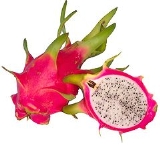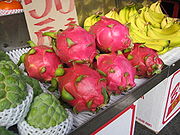
Hylocereus undatus
Encyclopedia
Hylocereus undatus is a species of Cactaceae and is the most cultivated species in the genus. It is used both as an ornamental vine and as a fruit crop - the Pitaya
or Dragonfruit. The native origin of the species has never been resolved.
 There is a locally famous cacti hedge on a lava rock wall of the Punahou School
There is a locally famous cacti hedge on a lava rock wall of the Punahou School
in Honolulu, the hedge of Kapunahou.
In 1836, Mrs. Bingham planted the hedge of Hylocereus undatus, the famed cactus known in Hawaii as panini o kapunahou. Its exotic blossoms still bloom during the closing summer months on the Punahou walls. The hedge is on two sides of the school and about three hundred meters (football fields) long.
From July to as late as October the hedge blooms and several times there is a wall of white flowers hundreds of yards long. Supposedly all the H. undatus in Hawaii came from the wall of Punahou School. People used to come in the evenings from all over the island to see them blooming and "borrow" some cuttings so that now they have this species all over the islands.
.
or xerophyte
. Needs a compost containing plenty of humus and sufficient moisture in summer. Should not be kept under 10°C (50°F) in winter. Can be grown in semi-shade or full sun. Extra light in the early spring will stimulate budding. Flowers in summer or autumn.
 Stems scandent, creeping, sprawling or clambering, branching profusely, 4-7,5 (-10) m long or more, joints to 30–120 cm long or more, 10–12 cm thick; ribs generally 3; margins corneous in age, undulate; areoles 2 mm in diameter; internodes 1–4 cm; spines on adult branches 1-3, 2–4 mm long, acicular to subconic, grayish brown to black, spreading; epidermis deep green. Flowers 25–30 cm long, 15–17 cm wide, nocturnal, scented; pericarpel 2,5–5 cm long, ca 2,5 cm thick, bracteoles ovate, acute, to 2,5 (-4 ) cm long; receptacle ca 3 cm thick, bracteoles linear-lanceolate, 3–8 cm long; outer tepals lanceolate-linear to linear, acuminate, 10–15 cm long, 10–15 mm wide mucronate, greenish yellow or whitish, rarely tinged rose; inner tepals lanceolate to oblanceolate, to 10–15 cm long ca 40 mm wide at widest point, mucronate, entire, acute to acuminate, white; stamens 5–10 cm long, declinate, inserted in one continuous zone from throat to 35 mm above pericarpel, cream; style to 17,5-24.5 cm long, stout, 6–8 mm thick, cream, stigma lobes to 26, entire or sometimes cleft at apex, cream, ca 25 mm long. Nectar chambers 30 mm long. Fruit oblong to ovoid, to 6–12 cm long, 4–9 cm thick, red with large bracteoles, pulp white, edible; seeds black.
Stems scandent, creeping, sprawling or clambering, branching profusely, 4-7,5 (-10) m long or more, joints to 30–120 cm long or more, 10–12 cm thick; ribs generally 3; margins corneous in age, undulate; areoles 2 mm in diameter; internodes 1–4 cm; spines on adult branches 1-3, 2–4 mm long, acicular to subconic, grayish brown to black, spreading; epidermis deep green. Flowers 25–30 cm long, 15–17 cm wide, nocturnal, scented; pericarpel 2,5–5 cm long, ca 2,5 cm thick, bracteoles ovate, acute, to 2,5 (-4 ) cm long; receptacle ca 3 cm thick, bracteoles linear-lanceolate, 3–8 cm long; outer tepals lanceolate-linear to linear, acuminate, 10–15 cm long, 10–15 mm wide mucronate, greenish yellow or whitish, rarely tinged rose; inner tepals lanceolate to oblanceolate, to 10–15 cm long ca 40 mm wide at widest point, mucronate, entire, acute to acuminate, white; stamens 5–10 cm long, declinate, inserted in one continuous zone from throat to 35 mm above pericarpel, cream; style to 17,5-24.5 cm long, stout, 6–8 mm thick, cream, stigma lobes to 26, entire or sometimes cleft at apex, cream, ca 25 mm long. Nectar chambers 30 mm long. Fruit oblong to ovoid, to 6–12 cm long, 4–9 cm thick, red with large bracteoles, pulp white, edible; seeds black.
Pitaya
A pitaya or pitahaya is the fruit of several cactus species, most importantly of the genus Hylocereus . These fruits are commonly known as dragon fruit – cf...
or Dragonfruit. The native origin of the species has never been resolved.
Common Names
- English: Red PitayaPitayaA pitaya or pitahaya is the fruit of several cactus species, most importantly of the genus Hylocereus . These fruits are commonly known as dragon fruit – cf...
, Red Pitahaya, Dragonfruit, Night blooming Cereus, Strawberry Pear, Belle of the Night, Conderella Plant - French: fruit du dragon, cierge-lézard, poire de chardon
- German: Drachenfrucht, Distelbirne
- Hawaiian: panini-o-ka-puna-hou ("Punahou cactus") - a famous specimen still grows at Punahou SchoolPunahou SchoolPunahou School, once known as Oahu College, is a private, co-educational, college preparatory school located in Honolulu CDP, City and County of Honolulu in the U.S. State of Hawaii...
- Portuguese: cato-barse, cardo-ananaz, rainha da noite
- Spanish: pitahaya roja (Colombia, Mexico, Venezuela); flor de caliz, pitajava (Puerto Rico); junco, junco tapatio, pitahaya orejona, reina de la noche, tasajo (Mexico)
- Swedish: skogskaktus, röd pitahaya
- Vietnamese: thanh long
- Thai: แก้วมังกร (kaeo mangkon)
- Malay: buah naga. pronounce:boo-ah naa-gaa
- Chinese: 火龙果 (huǒlóngguǒ)
History

Punahou School
Punahou School, once known as Oahu College, is a private, co-educational, college preparatory school located in Honolulu CDP, City and County of Honolulu in the U.S. State of Hawaii...
in Honolulu, the hedge of Kapunahou.
In 1836, Mrs. Bingham planted the hedge of Hylocereus undatus, the famed cactus known in Hawaii as panini o kapunahou. Its exotic blossoms still bloom during the closing summer months on the Punahou walls. The hedge is on two sides of the school and about three hundred meters (football fields) long.
From July to as late as October the hedge blooms and several times there is a wall of white flowers hundreds of yards long. Supposedly all the H. undatus in Hawaii came from the wall of Punahou School. People used to come in the evenings from all over the island to see them blooming and "borrow" some cuttings so that now they have this species all over the islands.
Origin and habitat
Lithophytic or hemiepiphytic. Widely distributed through the tropics in cultivation, it originates in Central AmericaCentral America
Central America is the central geographic region of the Americas. It is the southernmost, isthmian portion of the North American continent, which connects with South America on the southeast. When considered part of the unified continental model, it is considered a subcontinent...
.
Cultivation
An easily cultivated, fast growing epiphyteEpiphyte
An epiphyte is a plant that grows upon another plant non-parasitically or sometimes upon some other object , derives its moisture and nutrients from the air and rain and sometimes from debris accumulating around it, and is found in the temperate zone and in the...
or xerophyte
Xerophyte
A xerophyte or xerophytic organism is a plant which has adapted to survive in an environment that lacks water, such as a desert. Xerophytic plants may have adapted shapes and forms or internal functions that reduce their water loss or store water during long periods of dryness...
. Needs a compost containing plenty of humus and sufficient moisture in summer. Should not be kept under 10°C (50°F) in winter. Can be grown in semi-shade or full sun. Extra light in the early spring will stimulate budding. Flowers in summer or autumn.
Description


